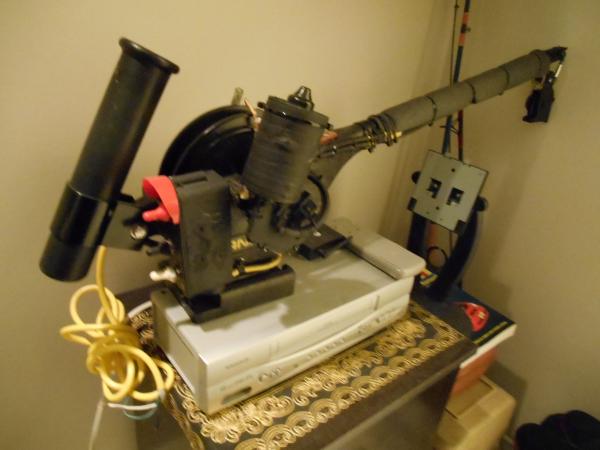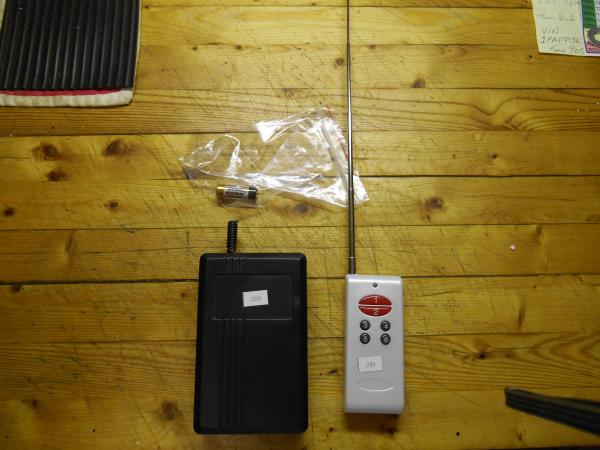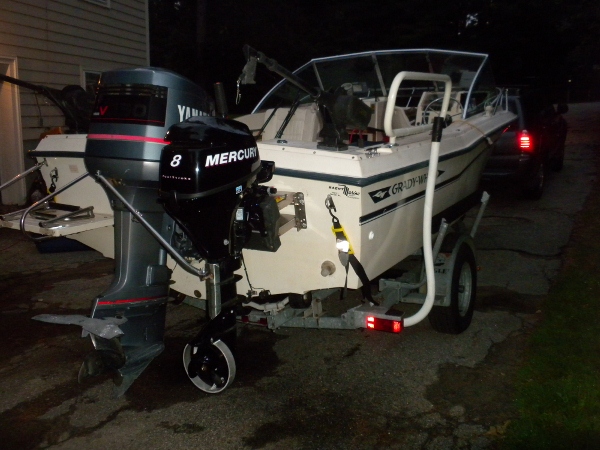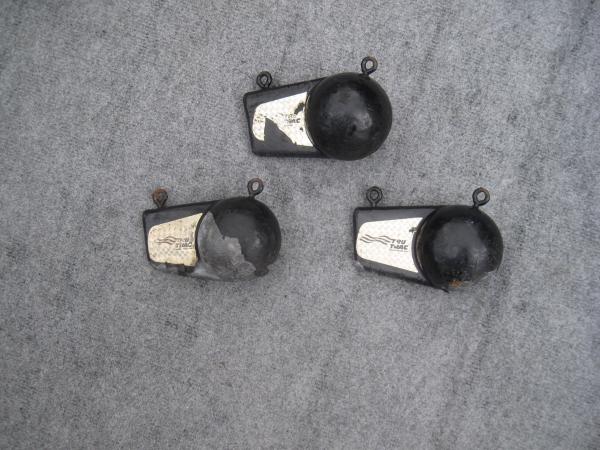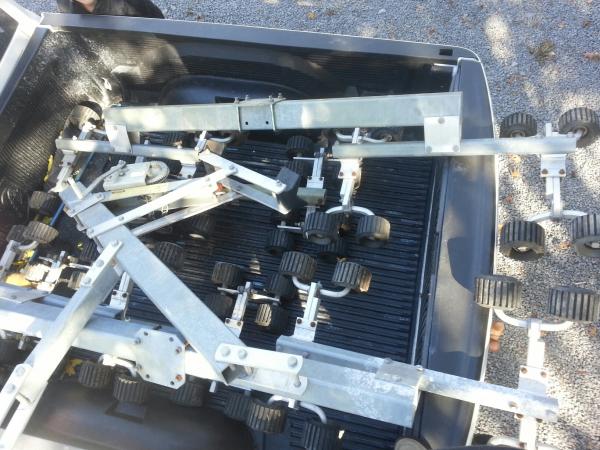-
Posts
74 -
Joined
-
Last visited
Everything posted by RSF
-
-
Hi, Depending on where the crack is, it may be more trusting in considering having it welded. At least you know what you have and can have it pressure tested externally before refitting. I would think having the cylinders bored, new rings..valve seats re-ground, would be the thing to do while its disassembled. In my experience, compression tests are done in three phases: Engine cold, Engine hot both using a wet and dry test. The wet test being a small amount of oil put in the cylinder being pressure tested, as if the resulting reading is 10 or more pounds higher than the dry test, there may be a valve problem...
-
Hi all, Thanks Jeremy! Spent years working the best electrical minds on another site trying to learn a work-around from obvious problems using a boat-mounted Infrared sensor approach but could could not get around the many false alarm problems associated with weather temperature, rain, etc.. Then moved on, a few years later 2015, included a meeting with an electronics design engineer. He said NO to IF and went into a spiel about about RF advantages as I was looking to design something for fishing industries capable of handling 12-15 deck hands in case of an overboard situation. We first discussed a constant-on device worn by all that interrupts the constant signal to a receiver on the stern, mast and bow which activates a light and audible alert in the helm. The problem was, in his thought, battery drain rate of crew wearing such a device since they may be out there (on deck) as much as 12-16 hours at a time. Then, we got into to an RF device worn by the crew with receivers located on the stern facing behind the boat. Where the crew member could press the remote device button setting off the alarms in the helm thus battery drain would not be a problem. After two hours and a few emails later, he wanted to design the whole unit (there are lot of extras with this device not mentioned above). Problem was His Electronics engineering firm sent an estimate of 54K plus for the finished design from etching to the cases. So I left it limbo. Then, while cruising through an electronics products exporter, I came across a low cost basic RF transmitter/receiver capable of operating four items.. so I ordered a few and have now begun the design for my boat as I do a lot of night fishing and sometimes alone. With my limited knowledge of antenna design in the RF spectrum 433 MHz plus, to increase range I decided to seek out advice here. Lake Ontario can be a problem lake with out of now where 6 foot waves... I know, as I got caught out there once 2 miles out where the shelf was. Anyway, I'm looking for any advice be it possitive or negative or just constructive critsism as I about to build the initial unit for my boat. Thanks.
-
Hi all, Here is the picture of the main controller unit. 80.00 in the USA, less than ten from the Country imported from. I have tested it. Minimal Range: 98 metres (Indoors) -TESTED. Perhaps 150 or more outdoors. However, I spent two days researching the 433 MGz band and found several ways to seriously increase the range. - Battery from: 3volt; to 5 volt - Parabolic Receiver antenna - Transmitter modification (simple solder thing, 2" copper wire-electron antenna atttachment) The three above mods I have not done as yet, but will in the coming days. Will report the results. Thanks Guys!
-
There's a place, just a mile or two of the north shore, south-west of Port Credit that I hit twice of four/five times fishing stainlines. Anyway it's called the depression though even Charter Boat Captains out of Port Credit insist does not exist. But it does. Drops from appx 65 feet to 170 feet and is quite short, eg 10 seconds and your out of it traveling north west by west. LOOK for seriously stained water and debri. Caught four Salmon there after dropping the rigger down on still to what I perceived (Old Humminbird) was the thermo.
-
So, received the components and did some testing then more antenna 433MGz research. Here is what I'm buliding and reasons why: Ski KeY advanced marine safety products (name I have come-up with) SK1L Strobe Warning SK2LM Strobe Warning/Engine Shut Down SK3LMEM Strobe Warning/Engine Shut Down/Electric Motor Shut Down SK4LMEM-AA Strobe Warning/Engine Shut Down/Electric Motor Shut Down/Audible Warning Custom made models that can save life and injury. The SK1L designed for the Water Skier or Tubing Rider which when activated will send a Radio Frequency signal in times of trouble, directly to the Captain through a four lamp high-powered LED strobing lamp signal mounted on the captain's or drivers gauge dashboard that will immediately alert the Captain a problem exists With the towed Skier, Tuber or wake boarder for an action. The SK2LM unit provides the addition to the above to be able to shut-down the drive engine as well as illuminate the captain's SkiKey Emergency dash mounted high powered strobe. The SK3LMEM unit provides in a addition to the SK1L and SK2LM, the enhancement of shutting down any Electric motor. THIS UNIT IS GENERALLY USED FOR THE SOLO Captain to shut down all active motors in case of a Overboard emergency. The SK4LMEMAA provide the same safety features as above and adds the ability to Switch-on an audible alarm, all while in water. NOTE: The above safety units are designed to enhance present safety methods and laws and are not designed or be used to replace existing or future water boat regulations. Am in the process of building my unit after good results testing the RF/Relay components I had ordered almost two months ago. From there, we'll see as I have sent a feeler message to some Fishing Pros and others. Asking give me your honest feedback on the series of Overboard Safety device models.
-

Cannon Digi-Troll TS 10 Problems
RSF replied to SmellsLikeFishNH's topic in Questions About Trout & Salmon Trolling?
Found it interesting that you mention it begins happening after about three hours of operation. If this is the case still, you might try taking a battery voltage reading when it begins (all systems off when taking the reading). The only common thing with your problem that is a constant would be possible battery drain - perhaps not a lot but enough. Here are battery voltage = Remaining charge level (12 volt): 12.6=100% Power Remaining 12.5=90% " 12.42=80% " 12.32=70% " 12.2=60% " 12.06=50% " 11.75=30% " 11.58=20% " 11.31=10% " 10.5=0% " I have seen equipment fail or give erroneous reading and/operation, including finders and other voltage-level specific items when a certain voltage thresh-hold is not maintained. Good luck. -
-
Hi all, Yes, I agree that ideally an electronically activated engine auto shut-down method would be best. But I was not able to come up with a way or device to do this without it being in constant contact (being on) with the receiver. What I came up with is a secondary system which I have finally received the components to build that yes, it will require pressing a button on the remote should one go overboard while not being tethered or alone. Just finished turning my Minn Kota C2 Endura trolling motor into a remote (wired) unit. It also includes steering. I must post a picture. Anyway, now I'm on to this project having finished the other and receiving the electronic parts for the remote engine shut down. I felt then as I do now, this simple system is a back-up while un-teathered for reasons such as checking the down-rigger, etc. I suspect unlike the other project this one won't take long to install and wire. I have the engine here on a pedestal so that's simple, the boat end of it I'll due in the Spring. I will post a picture in the coming weeks as to what it is and how it was done. Lol-hopefully it'll work.
-
Hi, Found my hook-ups almost doubled using my downrigger after I made a modification. One time while out on LO I noticed a hum while trolling at a depth of 140 ft. When I put my hand around the DR line I instantly knew the boat movement and engine vibration was the cause and that it must sending some of this down to the weight. A friend of mine who works for a builder of large mining Dump Trucks got me a foot of industrial 3/8" rubber. I measured, cut and insulated the DR mounting plate and boat, including pressure points of the four securing bolts which greatly reduced the vibration and almost completely-eliminated the hum. The result was huge in terms of increased hook-ups. I had mentioned this a year or two later to a friend who owned a charter service and he did the same with similar results.
-
Hi all, sorry taking this long to reply not been in, been building. Re: Overboard Engine-Shut Down device, Due to battery drain it would difficult to design a small transmitter that continuously transmits where the engine-off system activates upon being out of range (in water) of receiver without a much larger transmitter to house a much larger battery. Per an Engineer I met with back in August/15. So, in this case, in order to keep small (car remote size), it will depend on pressing a button that will, in this case, shut down the engine through the usual ground-off method, while activating an SOS strobe. The receiver unit 3"x3" will mount between he stern lamp and pole and the wiring (four + stern lamp wires) will run down/up through the stern lamp pole, keeping the receiver as high as possible. In large craft the bridge or cabin top-rear area may be best. The high intensity multi, 360 degree SOS strobe I may mount on top of the engine cowl?, as vibration wont bother it. The cost of the parts, less wire, fuses, switches, connectors, solder and 10-15 hours I'll spend building it, is 52.00 CDN. I'm also designing a commercial version that will accommodate 1-12 crew. Almost finished turning my Min Kota Endura C60 from tiller to remote-controlled (wired). Added electronic steering to. Not enough room on stern, so had to mount on bow. When mounted this Spring, I'll be able to operate the trolling motor from my seat (3-reverse, five forward speeds and electric steering, just under 90 degrees port or starboard. Will post pictures when done. The remote control is finished and assembled, just need to complete mounting the old 14 volt drill to trolling motor frame -- screw drive steering's done too.
-
Hi all, hoping your having a great Christmas season! Wanted to let you know, I'm in final phase of development soon to go into test mode of a special wireless device that will shut-down your/my outboard, inboard or diesal boat engine should a lone captain fall overboard while the engine is on or on & engaged.
-
Three day excursion trip with smaller boats ready for summer 2016 Launch: Chippawa, south to Erie, across to Long Point for a night and return. Those who are interested in planning this trip please PM me. Suggested launch last Thursday of June. Camp on board or there are a few places we can stop & dock. Return trip will happen mid-Saturday regardless of making long point or not. Must be licensed and have a reliable engine.
-

For Sale : USA 3 tru trac downrigger weights
RSF replied to Waynes World's topic in Classifieds - Buy, Sell, Trade or Rent
-

For Sale : USA Daiwa Tournament Series SS spinning
RSF replied to Tunaman1's topic in Classifieds - Buy, Sell, Trade or Rent
Great Reels. I've owned my SGA1355 thirty-five years and use it for Walley and have caught 22 lb Pike with 9 lb spider wire to this day. Also own a PEN 509 for all Musky, Lake Tout and Salmon. Wouldn't replace either. -
15.00 CDN ?
-

For Sale : USA EZ-Loader trailer rarms and rollers
RSF replied to orange belly's topic in Classifieds - Buy, Sell, Trade or Rent
-
There are a few books out there on how to handle a weather/wave blow-up while out. Read it once, saved my life one day. Teaches how to ride the 6' plus waves and manipulate raising the bow to get over and increasing throttle preventing being swamped from behind. The best safety article I have ever read..I'm still around as my Son who was with me that fateful day.
-
You may find switching from Volvo 351 (FORD Windsor? (if so-good engines)) wiring to helm may need a change-out too if Re&Re with diff OEM engines.
-

How to add charging to manual-start Merc 9.9 4 stroke?
RSF replied to Gill-T's topic in This Old Boat
I use the six amp regulated on my merc 9.9 type M. And yes, four amp output will kick in at about half throttle 3K..and increase from there and max 6 Amp at about 5300 RPM (appx 3/4 throttle). However, I believe CDI made and may still make a 9-10 amp set-up which includes a stator. But I say 6 Amps is better than 0 Amps and as others have said, I too run two batteries. The big deep cycle for the 60lb thrust electric, downrigger and bilge pump. The main for all other light draw stuff. Both batteries have a small trickle charge solarpanel and both batteries are removed and kept charged at home using a 'smart charger'. -
Hope you don't have a fume or gas leak while away..I don't trust pumps turning on/off on their own. Especially I/O or I.
-
Always read the switch/fuse panel instructions for Maximum amperage per switch. Same with items to be connected. If any items don't have the information on them or no instructions pamphlets are available, I'd look-up and consult the manufacturer. As mentioned above re the bilge pump..it can spike hence hooking up direct to battery. I didn't but had to rewire (14 to 10 gauge) and change out one of the switch panel switches and fuse to accommodate. Above all, the main line from the fuse/switch panel 10-8 gauge depending on length of run, must be fused 8-10 inches from but directly to battery positive. I add all max amperage of all lights/pump/marine radio... and subtract 20% and use that amperage rated fuse at battery. If it blows and there's no short or loose connection within all connections, I'll replace the battery fuse adding five-amps.
-
I modified my Lake Troll from manual to electric at a cost of about 60.00. Did it once before in the late eighties after only one time of cranking that old canon up 140' . This time I left the hand crank on (other side) and designed quick motor drive dis-engagement contraption lol, in case I run out of battery power. Both worked great and I save 400-500.00 .
-

best bet for small boat
RSF replied to psychodad's topic in Ontario, CA Fishing Reports - Lake Ontario (North Shore)
Wear a quick release seatbelt. I owned a 14' fibreglass/40 Merc and got caught out about 1.5 miles from perfectly calm to 6 foot swells and a little wind. Launched from Marie Curtis, bye the time I followed the waves semi-diagonally back-in, in order to not get swamped bow/stern, I landed in breakwater at Port Credit, about 8 miles west of Marie Curtis. If you have not done so, read-up on methods to increase chances of getting-in when caught in unexpected winds and high white caps..it could save your life. It will also tell you how to manipulate your engine-throttle and how to ride the highest of waves. Generally speaking forget about being able to go straight-in. Get on the cell and let the Coast Guard know your approximate location and compass direction toward shore (always take a radio (weather reports) and the Coast Guard emergency number.


